UGB361 Report: Reflective Learning Approaches for HR Practice
VerifiedAdded on 2023/06/10
|6
|1337
|214
Report
AI Summary
This report delves into reflective learning approaches, crucial for professional development, particularly within the context of HR practice. It examines various methods, including the Gibbs reflective cycle, reflection in action, swampy lowlands, and liminal space, providing a comprehensive overview of their application. The report analyzes how these approaches can be utilized to critically evaluate experiences, enhance decision-making, and foster continuous improvement, as demonstrated through the student's annotated blog and its focus on the CIPD framework. The report also critiques and justifies the use of these approaches in the design of an artful annotated vlog or audio blog. The literature review includes an annotated bibliography, and the method section provides explanations and justifications for the methods used, specifically highlighting the application of the Gibbs reflective cycle within the blog. The research aims to provide a critical qualitative inquiry on the Annotated Blog CIPD 2022.
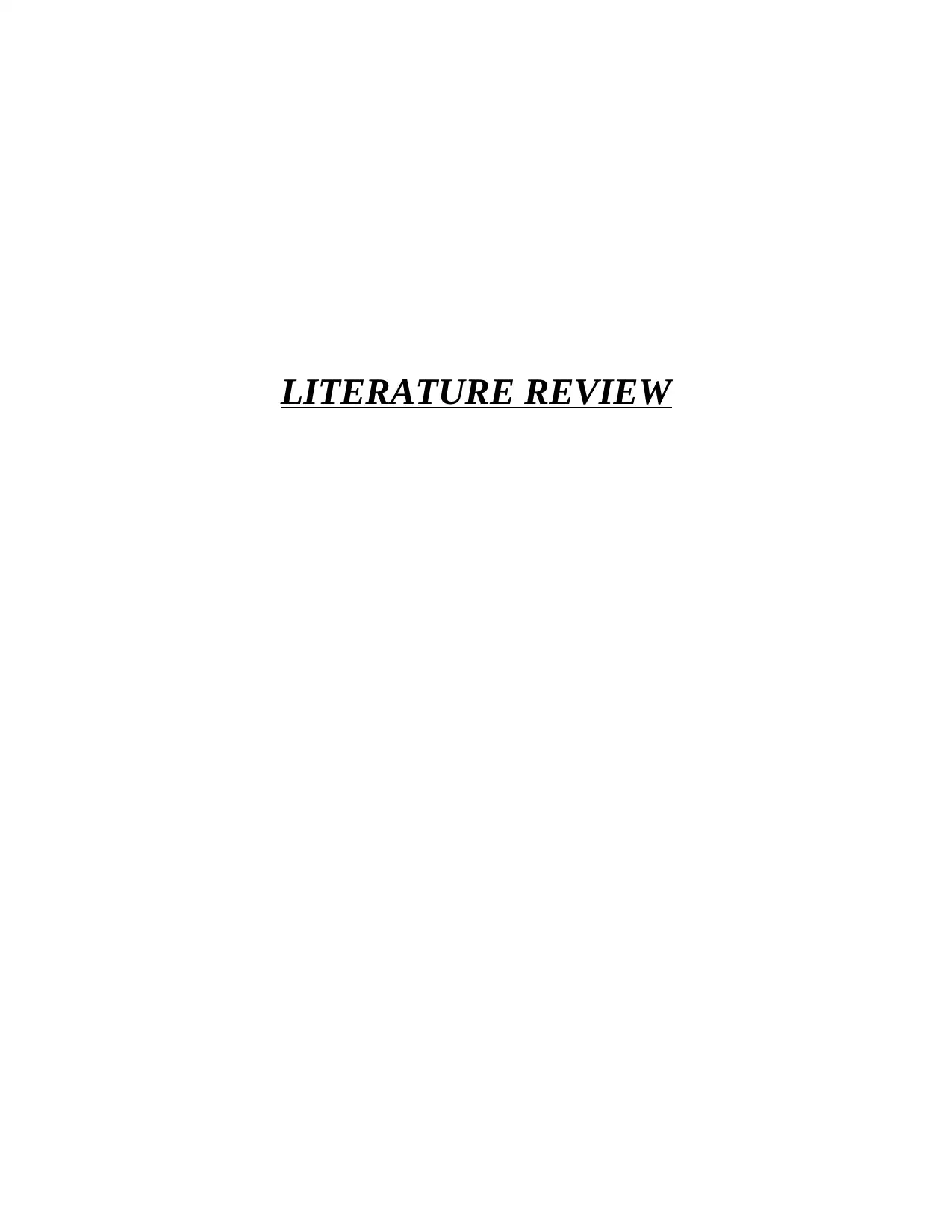
LITERATURE REVIEW
Paraphrase This Document
Need a fresh take? Get an instant paraphrase of this document with our AI Paraphraser
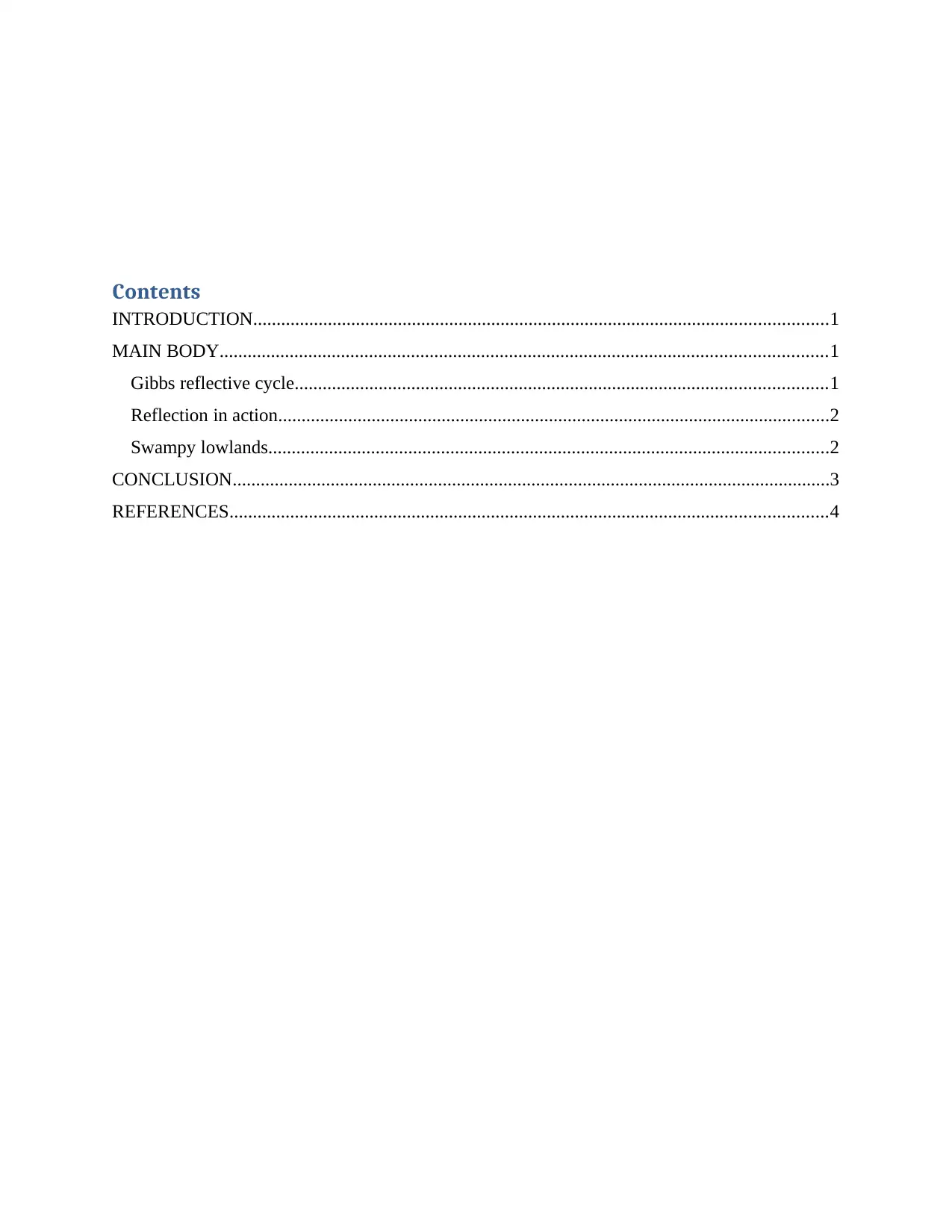
Contents
INTRODUCTION...........................................................................................................................1
MAIN BODY..................................................................................................................................1
Gibbs reflective cycle..................................................................................................................1
Reflection in action......................................................................................................................2
Swampy lowlands........................................................................................................................2
CONCLUSION................................................................................................................................3
REFERENCES................................................................................................................................4
INTRODUCTION...........................................................................................................................1
MAIN BODY..................................................................................................................................1
Gibbs reflective cycle..................................................................................................................1
Reflection in action......................................................................................................................2
Swampy lowlands........................................................................................................................2
CONCLUSION................................................................................................................................3
REFERENCES................................................................................................................................4
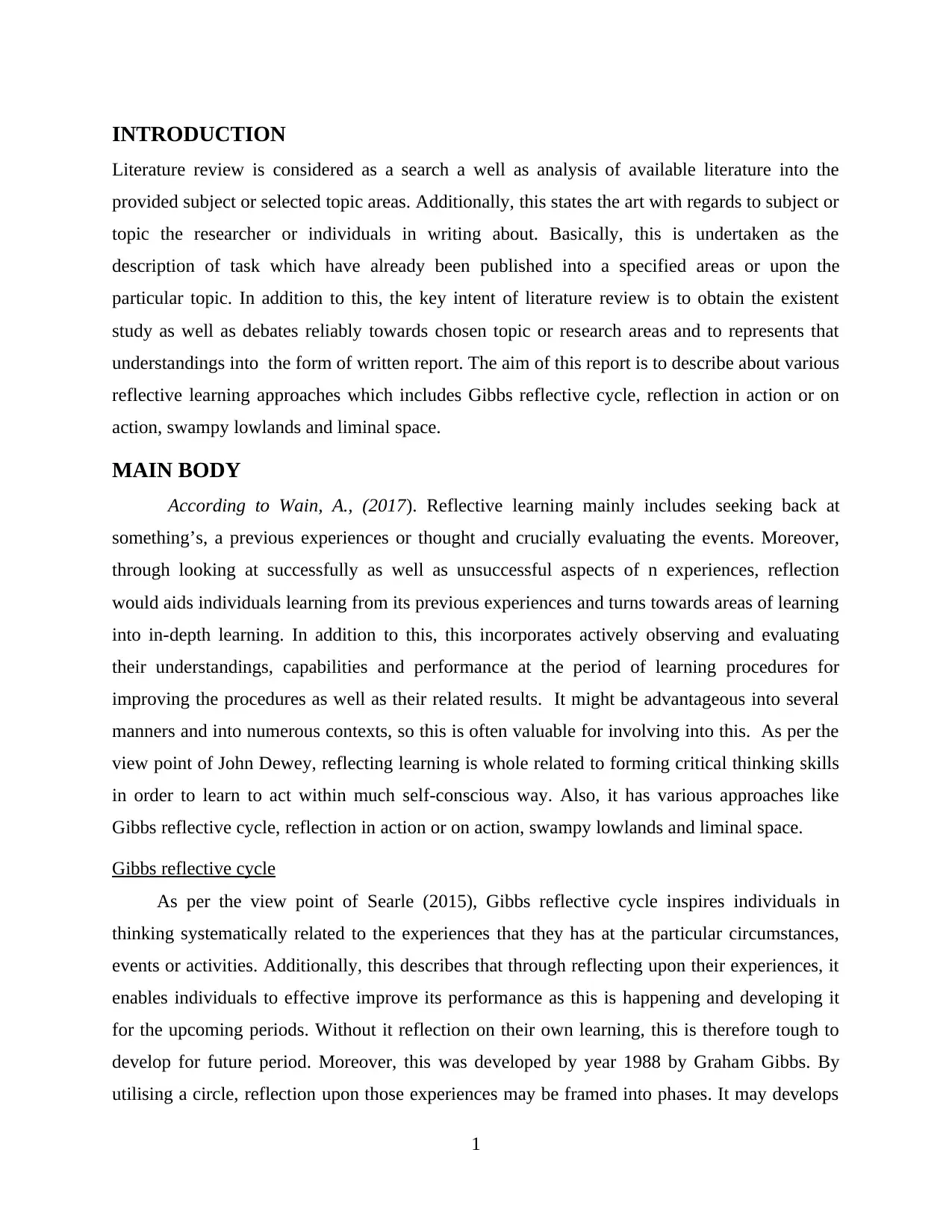
INTRODUCTION
Literature review is considered as a search a well as analysis of available literature into the
provided subject or selected topic areas. Additionally, this states the art with regards to subject or
topic the researcher or individuals in writing about. Basically, this is undertaken as the
description of task which have already been published into a specified areas or upon the
particular topic. In addition to this, the key intent of literature review is to obtain the existent
study as well as debates reliably towards chosen topic or research areas and to represents that
understandings into the form of written report. The aim of this report is to describe about various
reflective learning approaches which includes Gibbs reflective cycle, reflection in action or on
action, swampy lowlands and liminal space.
MAIN BODY
According to Wain, A., (2017). Reflective learning mainly includes seeking back at
something’s, a previous experiences or thought and crucially evaluating the events. Moreover,
through looking at successfully as well as unsuccessful aspects of n experiences, reflection
would aids individuals learning from its previous experiences and turns towards areas of learning
into in-depth learning. In addition to this, this incorporates actively observing and evaluating
their understandings, capabilities and performance at the period of learning procedures for
improving the procedures as well as their related results. It might be advantageous into several
manners and into numerous contexts, so this is often valuable for involving into this. As per the
view point of John Dewey, reflecting learning is whole related to forming critical thinking skills
in order to learn to act within much self-conscious way. Also, it has various approaches like
Gibbs reflective cycle, reflection in action or on action, swampy lowlands and liminal space.
Gibbs reflective cycle
As per the view point of Searle (2015), Gibbs reflective cycle inspires individuals in
thinking systematically related to the experiences that they has at the particular circumstances,
events or activities. Additionally, this describes that through reflecting upon their experiences, it
enables individuals to effective improve its performance as this is happening and developing it
for the upcoming periods. Without it reflection on their own learning, this is therefore tough to
develop for future period. Moreover, this was developed by year 1988 by Graham Gibbs. By
utilising a circle, reflection upon those experiences may be framed into phases. It may develops
1
Literature review is considered as a search a well as analysis of available literature into the
provided subject or selected topic areas. Additionally, this states the art with regards to subject or
topic the researcher or individuals in writing about. Basically, this is undertaken as the
description of task which have already been published into a specified areas or upon the
particular topic. In addition to this, the key intent of literature review is to obtain the existent
study as well as debates reliably towards chosen topic or research areas and to represents that
understandings into the form of written report. The aim of this report is to describe about various
reflective learning approaches which includes Gibbs reflective cycle, reflection in action or on
action, swampy lowlands and liminal space.
MAIN BODY
According to Wain, A., (2017). Reflective learning mainly includes seeking back at
something’s, a previous experiences or thought and crucially evaluating the events. Moreover,
through looking at successfully as well as unsuccessful aspects of n experiences, reflection
would aids individuals learning from its previous experiences and turns towards areas of learning
into in-depth learning. In addition to this, this incorporates actively observing and evaluating
their understandings, capabilities and performance at the period of learning procedures for
improving the procedures as well as their related results. It might be advantageous into several
manners and into numerous contexts, so this is often valuable for involving into this. As per the
view point of John Dewey, reflecting learning is whole related to forming critical thinking skills
in order to learn to act within much self-conscious way. Also, it has various approaches like
Gibbs reflective cycle, reflection in action or on action, swampy lowlands and liminal space.
Gibbs reflective cycle
As per the view point of Searle (2015), Gibbs reflective cycle inspires individuals in
thinking systematically related to the experiences that they has at the particular circumstances,
events or activities. Additionally, this describes that through reflecting upon their experiences, it
enables individuals to effective improve its performance as this is happening and developing it
for the upcoming periods. Without it reflection on their own learning, this is therefore tough to
develop for future period. Moreover, this was developed by year 1988 by Graham Gibbs. By
utilising a circle, reflection upon those experiences may be framed into phases. It may develops
1
⊘ This is a preview!⊘
Do you want full access?
Subscribe today to unlock all pages.

Trusted by 1+ million students worldwide
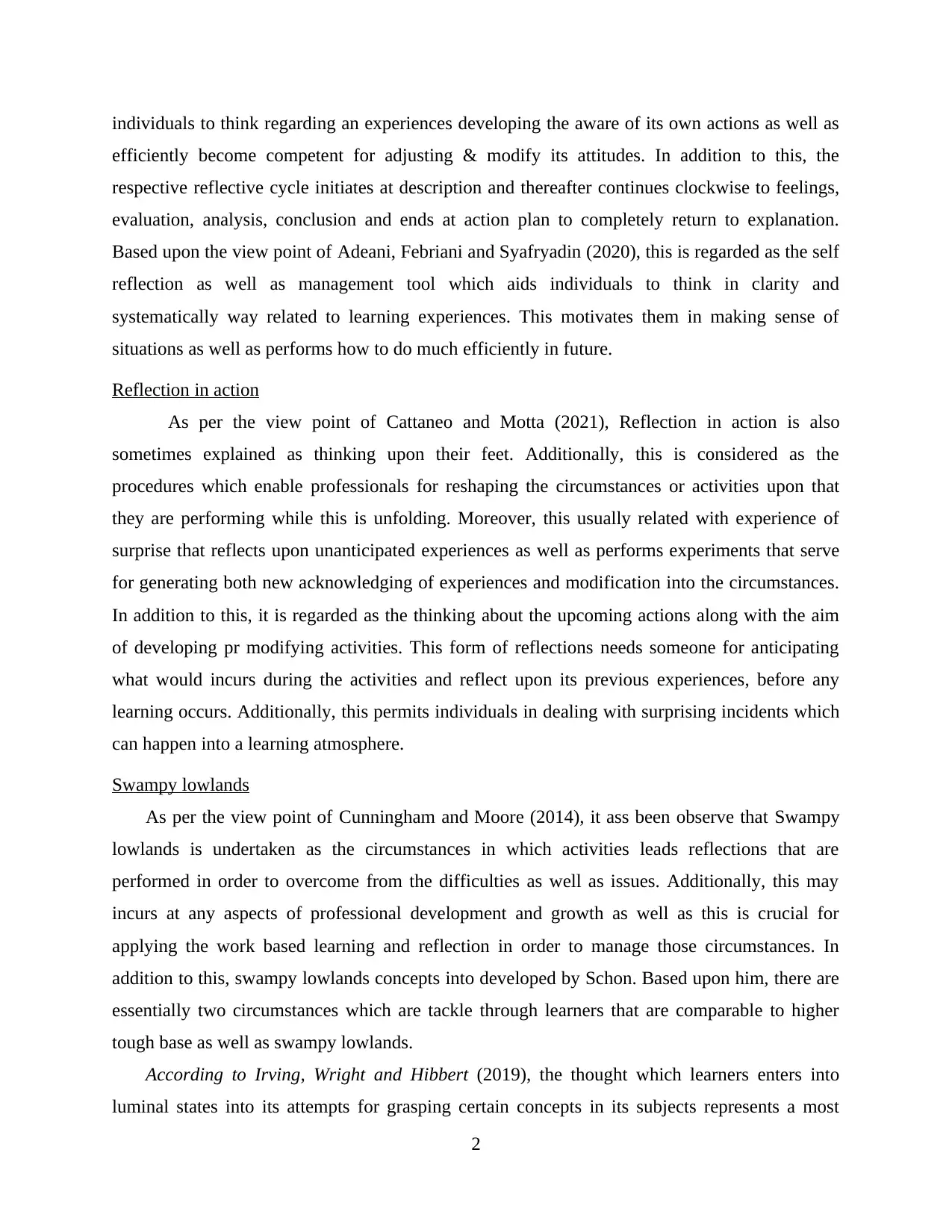
individuals to think regarding an experiences developing the aware of its own actions as well as
efficiently become competent for adjusting & modify its attitudes. In addition to this, the
respective reflective cycle initiates at description and thereafter continues clockwise to feelings,
evaluation, analysis, conclusion and ends at action plan to completely return to explanation.
Based upon the view point of Adeani, Febriani and Syafryadin (2020), this is regarded as the self
reflection as well as management tool which aids individuals to think in clarity and
systematically way related to learning experiences. This motivates them in making sense of
situations as well as performs how to do much efficiently in future.
Reflection in action
As per the view point of Cattaneo and Motta (2021), Reflection in action is also
sometimes explained as thinking upon their feet. Additionally, this is considered as the
procedures which enable professionals for reshaping the circumstances or activities upon that
they are performing while this is unfolding. Moreover, this usually related with experience of
surprise that reflects upon unanticipated experiences as well as performs experiments that serve
for generating both new acknowledging of experiences and modification into the circumstances.
In addition to this, it is regarded as the thinking about the upcoming actions along with the aim
of developing pr modifying activities. This form of reflections needs someone for anticipating
what would incurs during the activities and reflect upon its previous experiences, before any
learning occurs. Additionally, this permits individuals in dealing with surprising incidents which
can happen into a learning atmosphere.
Swampy lowlands
As per the view point of Cunningham and Moore (2014), it ass been observe that Swampy
lowlands is undertaken as the circumstances in which activities leads reflections that are
performed in order to overcome from the difficulties as well as issues. Additionally, this may
incurs at any aspects of professional development and growth as well as this is crucial for
applying the work based learning and reflection in order to manage those circumstances. In
addition to this, swampy lowlands concepts into developed by Schon. Based upon him, there are
essentially two circumstances which are tackle through learners that are comparable to higher
tough base as well as swampy lowlands.
According to Irving, Wright and Hibbert (2019), the thought which learners enters into
luminal states into its attempts for grasping certain concepts in its subjects represents a most
2
efficiently become competent for adjusting & modify its attitudes. In addition to this, the
respective reflective cycle initiates at description and thereafter continues clockwise to feelings,
evaluation, analysis, conclusion and ends at action plan to completely return to explanation.
Based upon the view point of Adeani, Febriani and Syafryadin (2020), this is regarded as the self
reflection as well as management tool which aids individuals to think in clarity and
systematically way related to learning experiences. This motivates them in making sense of
situations as well as performs how to do much efficiently in future.
Reflection in action
As per the view point of Cattaneo and Motta (2021), Reflection in action is also
sometimes explained as thinking upon their feet. Additionally, this is considered as the
procedures which enable professionals for reshaping the circumstances or activities upon that
they are performing while this is unfolding. Moreover, this usually related with experience of
surprise that reflects upon unanticipated experiences as well as performs experiments that serve
for generating both new acknowledging of experiences and modification into the circumstances.
In addition to this, it is regarded as the thinking about the upcoming actions along with the aim
of developing pr modifying activities. This form of reflections needs someone for anticipating
what would incurs during the activities and reflect upon its previous experiences, before any
learning occurs. Additionally, this permits individuals in dealing with surprising incidents which
can happen into a learning atmosphere.
Swampy lowlands
As per the view point of Cunningham and Moore (2014), it ass been observe that Swampy
lowlands is undertaken as the circumstances in which activities leads reflections that are
performed in order to overcome from the difficulties as well as issues. Additionally, this may
incurs at any aspects of professional development and growth as well as this is crucial for
applying the work based learning and reflection in order to manage those circumstances. In
addition to this, swampy lowlands concepts into developed by Schon. Based upon him, there are
essentially two circumstances which are tackle through learners that are comparable to higher
tough base as well as swampy lowlands.
According to Irving, Wright and Hibbert (2019), the thought which learners enters into
luminal states into its attempts for grasping certain concepts in its subjects represents a most
2
Paraphrase This Document
Need a fresh take? Get an instant paraphrase of this document with our AI Paraphraser
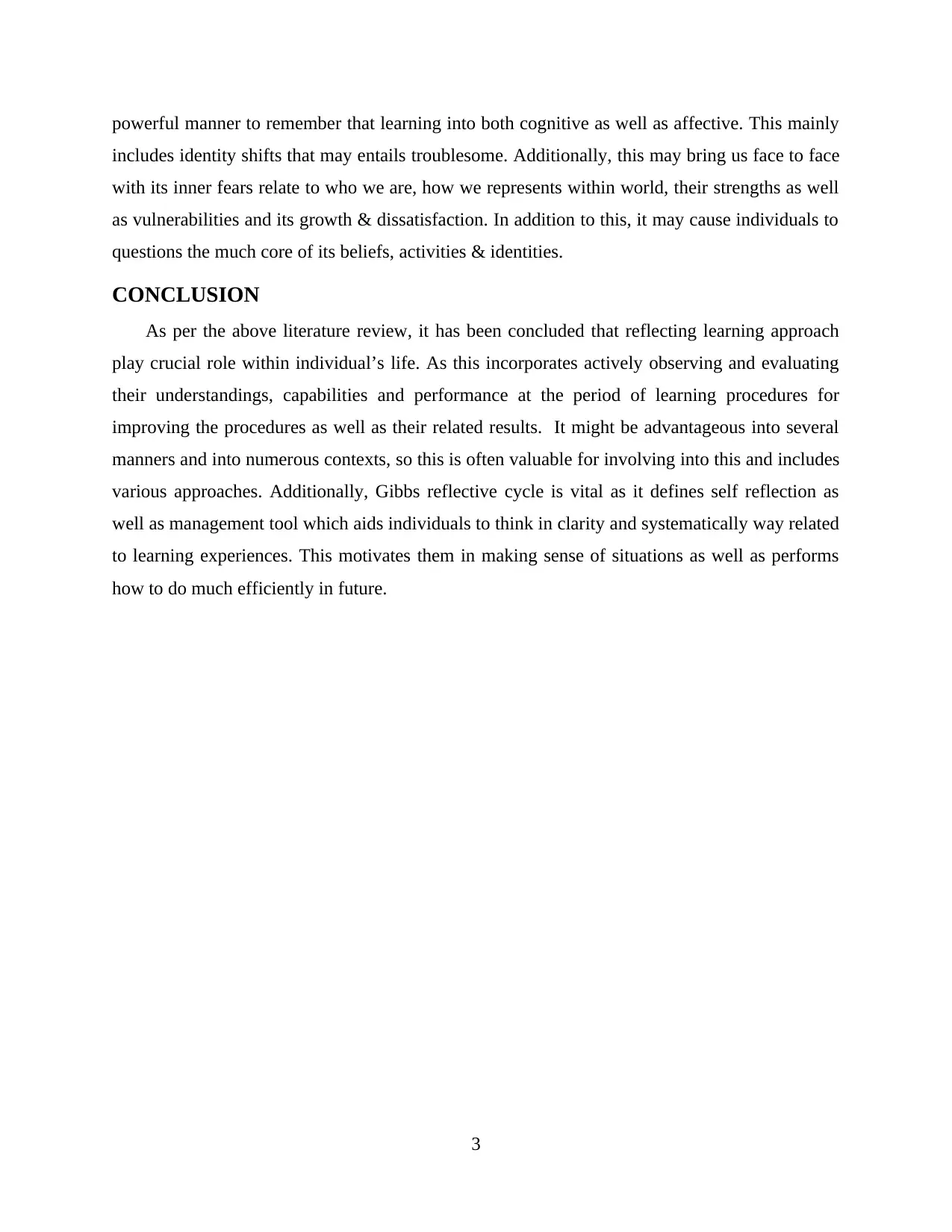
powerful manner to remember that learning into both cognitive as well as affective. This mainly
includes identity shifts that may entails troublesome. Additionally, this may bring us face to face
with its inner fears relate to who we are, how we represents within world, their strengths as well
as vulnerabilities and its growth & dissatisfaction. In addition to this, it may cause individuals to
questions the much core of its beliefs, activities & identities.
CONCLUSION
As per the above literature review, it has been concluded that reflecting learning approach
play crucial role within individual’s life. As this incorporates actively observing and evaluating
their understandings, capabilities and performance at the period of learning procedures for
improving the procedures as well as their related results. It might be advantageous into several
manners and into numerous contexts, so this is often valuable for involving into this and includes
various approaches. Additionally, Gibbs reflective cycle is vital as it defines self reflection as
well as management tool which aids individuals to think in clarity and systematically way related
to learning experiences. This motivates them in making sense of situations as well as performs
how to do much efficiently in future.
3
includes identity shifts that may entails troublesome. Additionally, this may bring us face to face
with its inner fears relate to who we are, how we represents within world, their strengths as well
as vulnerabilities and its growth & dissatisfaction. In addition to this, it may cause individuals to
questions the much core of its beliefs, activities & identities.
CONCLUSION
As per the above literature review, it has been concluded that reflecting learning approach
play crucial role within individual’s life. As this incorporates actively observing and evaluating
their understandings, capabilities and performance at the period of learning procedures for
improving the procedures as well as their related results. It might be advantageous into several
manners and into numerous contexts, so this is often valuable for involving into this and includes
various approaches. Additionally, Gibbs reflective cycle is vital as it defines self reflection as
well as management tool which aids individuals to think in clarity and systematically way related
to learning experiences. This motivates them in making sense of situations as well as performs
how to do much efficiently in future.
3
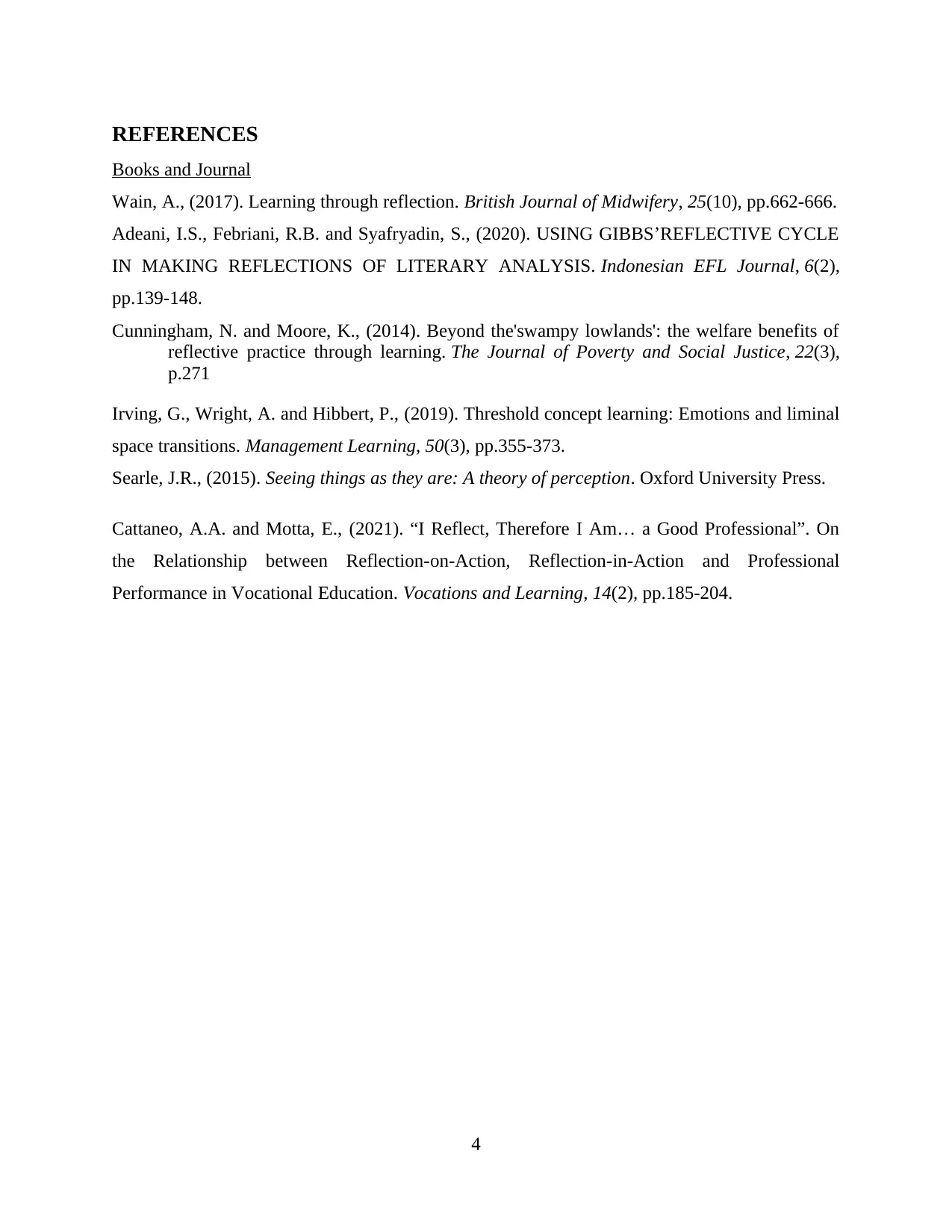
REFERENCES
Books and Journal
Wain, A., (2017). Learning through reflection. British Journal of Midwifery, 25(10), pp.662-666.
Adeani, I.S., Febriani, R.B. and Syafryadin, S., (2020). USING GIBBS’REFLECTIVE CYCLE
IN MAKING REFLECTIONS OF LITERARY ANALYSIS. Indonesian EFL Journal, 6(2),
pp.139-148.
Cunningham, N. and Moore, K., (2014). Beyond the'swampy lowlands': the welfare benefits of
reflective practice through learning. The Journal of Poverty and Social Justice, 22(3),
p.271
Irving, G., Wright, A. and Hibbert, P., (2019). Threshold concept learning: Emotions and liminal
space transitions. Management Learning, 50(3), pp.355-373.
Searle, J.R., (2015). Seeing things as they are: A theory of perception. Oxford University Press.
Cattaneo, A.A. and Motta, E., (2021). “I Reflect, Therefore I Am… a Good Professional”. On
the Relationship between Reflection-on-Action, Reflection-in-Action and Professional
Performance in Vocational Education. Vocations and Learning, 14(2), pp.185-204.
4
Books and Journal
Wain, A., (2017). Learning through reflection. British Journal of Midwifery, 25(10), pp.662-666.
Adeani, I.S., Febriani, R.B. and Syafryadin, S., (2020). USING GIBBS’REFLECTIVE CYCLE
IN MAKING REFLECTIONS OF LITERARY ANALYSIS. Indonesian EFL Journal, 6(2),
pp.139-148.
Cunningham, N. and Moore, K., (2014). Beyond the'swampy lowlands': the welfare benefits of
reflective practice through learning. The Journal of Poverty and Social Justice, 22(3),
p.271
Irving, G., Wright, A. and Hibbert, P., (2019). Threshold concept learning: Emotions and liminal
space transitions. Management Learning, 50(3), pp.355-373.
Searle, J.R., (2015). Seeing things as they are: A theory of perception. Oxford University Press.
Cattaneo, A.A. and Motta, E., (2021). “I Reflect, Therefore I Am… a Good Professional”. On
the Relationship between Reflection-on-Action, Reflection-in-Action and Professional
Performance in Vocational Education. Vocations and Learning, 14(2), pp.185-204.
4
⊘ This is a preview!⊘
Do you want full access?
Subscribe today to unlock all pages.

Trusted by 1+ million students worldwide
1 out of 6
Related Documents
Your All-in-One AI-Powered Toolkit for Academic Success.
+13062052269
info@desklib.com
Available 24*7 on WhatsApp / Email
![[object Object]](/_next/static/media/star-bottom.7253800d.svg)
Unlock your academic potential
Copyright © 2020–2025 A2Z Services. All Rights Reserved. Developed and managed by ZUCOL.




